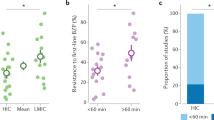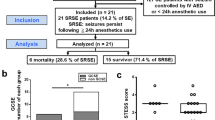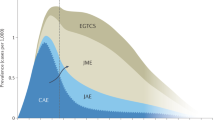Abstract
Nonconvulsive status epilepticus (NCSE) encompasses a wide range of diagnoses with variable outcomes and treatment recommendations. In children, NCSE can be observed in various conditions, including acute neurological injuries, specific childhood epilepsy syndromes and other neurological conditions, and can also be observed in individuals with learning difficulties. NCSE in children is thought to be under-recognized, and further studies examining the electrographic characteristics of very young children in NCSE would aid the prompt recognition of additional patients. Some subtypes of NCSE are probably more harmful than others, and long-term prospective studies are needed to evaluate the damaging potential of NCSE itself as opposed to that of the underlying circumstances in which it occurs. Specific data in childhood are clearly lacking, but extrapolation from adult studies indicates that aggressive treatment is most warranted in comatose patients. By contrast, a cautious approach seems to be indicated for absence status epilepticus, complex partial status epilepticus and electrical status epilepticus during sleep.
Key Points
-
Nonconvulsive status epilepticus (NCSE) has been defined as a cognitive or behavioral change that lasts for at least 30 minutes, with evidence of seizures on electroencephalogram
-
The diagnosis of NCSE is difficult and requires a high index of suspicion; the condition is probably under-recognized
-
The variation in the conditions encompassed by the term NCSE and the lack of agreement on diagnostic criteria, such as electroencephalographic features, contribute to its problematic identification
-
NCSE is notoriously observed in various childhood epilepsy syndromes, encephalopathies and acute conditions
-
Clear data regarding diagnosis, treatment and outcome of NCSE are particularly wanting in children
-
Further studies analyzing the electroencephalographic features and clinical presentation of NCSE in children, especially the very young, are needed
This is a preview of subscription content, access via your institution
Access options
Subscribe to this journal
Receive 12 print issues and online access
$209.00 per year
only $17.42 per issue
Buy this article
- Purchase on Springer Link
- Instant access to full article PDF
Prices may be subject to local taxes which are calculated during checkout



Similar content being viewed by others
References
Commission on Terminology of the International League against Epilepsy (1964) A proposed international classification of epileptic seizures. Epilepsia 157: 297–306
Meldrum BS and Brierley JB (1973) Prolonged epileptic seizures in primates: ischemic cell change and its relation to ictal physiological events. Arch Neurol 28: 10–17
Lowenstein DH (1999) Status epilepticus: an overview of the clinical problem. Epilepsia 40 (Suppl 1): S3–S8
International League against Epilepsy: Glossary of descriptive terminology for ictal semiology [http://www.ilae-epilepsy.org/Visitors/Centre/ctf/glossary.cfm]
Kaplan PW (2000) Prognosis in nonconvulsive status epilepticus. Epileptic Disord 2: 185–193
Walker MC (2001) Diagnosis and treatment of nonconvulsive status epilepticus. CNS Drugs 15: 931–939
Husain AM et al. (1999) Generalized periodic epileptiform discharges: etiologies, relationship to status epilepticus, and prognosis. J Clin Neurophysiol 16: 51–58
Walker M et al. (2005) Nonconvulsive status epilepticus: Epilepsy Research Foundation workshop reports. Epileptic Disord 7: 253–296
Walker MC (2003) Status epilepticus on the intensive care unit. J Neurol 250: 401–406
Shorvon S (2001) The management of status epilepticus. J Neurol Neurosurg Psychiatry 70 (Suppl 2): II22–II27
Williamson PD et al. (1985) Complex partial seizures of frontal lobe origin. Ann Neurol 18: 497–504
Cascino GD (1993) Nonconvulsive status epilepticus in adults and children. Epilepsia 34 (Suppl 1): S21–S28
Krumholz A (1999) Epidemiology and evidence for morbidity of nonconvulsive status epilepticus. J Clin Neurophysiol 16: 314–322
Arzimanoglou A et al. (2004) Status epilepticus. In Aicardi's Epilepsy in Children, edn 3, 241–261 (Eds Arzimanoglou A et al.) Philadelphia: Lippincott Williams & Wilkins
Scholtes FB et al. (2005) Cognitive deterioration and electrical status epilepticus during slow sleep. Epilepsy Behav 6: 167–173
Dirik E et al. (2006) Nonconvulsive status epilepticus and neurodevelopmental delay. Pediatr Neurol 35: 209–212
Towne AR et al. (2000) Prevalence of nonconvulsive status epilepticus in comatose patients. Neurology 54: 340–345
Young GB et al. (1996) An assessment of nonconvulsive seizures in the intensive care unit using continuous EEG monitoring: an investigation of variables associated with mortality. Neurology 47: 83–89
Lowenstein DH and Aminoff MJ (1992) Clinical and EEG features of status epilepticus in comatose patients. Neurology 42: 100–104
DeLorenzo RJ et al. (1998) Persistent nonconvulsive status epilepticus after the control of convulsive status epilepticus. Epilepsia 39: 833–840
Riviello JJ Jr et al. (2006) Practice parameter: diagnostic assessment of the child with status epilepticus (an evidence-based review): report of the Quality Standards Subcommittee of the American Academy of Neurology and the Practice Committee of the Child Neurology Society. Neurology 67: 1542–1550
Tay SK et al. (2006) Nonconvulsive status epilepticus in children: clinical and EEG characteristics. Epilepsia 47: 1504–1509
Hyllienmark L and Amark P (2007) Continuous EEG monitoring in a paediatric intensive care unit. Eur J Paediatr Neurol 11: 70–75
Jette N et al. (2006) Frequency and predictors of nonconvulsive seizures during continuous electroencephalographic monitoring in critically ill children. Arch Neurol 63: 1750–1755
Hosain SA et al. (2005) Electroencephalographic patterns in unresponsive pediatric patients. Pediatr Neurol 32: 162–165
Saengpattrachai M et al. (2006) Nonconvulsive seizures in the pediatric intensive care unit: etiology, EEG, and brain imaging findings. Epilepsia 47: 1510–1518
Drislane FW (1999) Evidence against permanent neurologic damage from nonconvulsive status epilepticus. J Clin Neurophysiol 16: 323–331
Chong DJ and Hirsch LJ (2005) Which EEG patterns warrant treatment in the critically ill? Reviewing the evidence for treatment of periodic epileptiform discharges and related patterns. J Clin Neurophysiol 22: 79–91
Snodgrass SM et al. (1989) Clinical significance of periodic lateralized epileptiform discharges: relationship with status epilepticus. J Clin Neurophysiol 6: 159–172
Terzano MG et al. (1986) Confusional states with periodic lateralized epileptiform discharges (PLEDs): a peculiar epileptic syndrome in the elderly. Epilepsia 27: 446–457
Assal F et al. (2001) SPECT in periodic lateralized epileptiform discharges (PLEDs): a form of partial status epilepticus? Seizure 10: 260–265
Westmoreland BF et al. (1986) Chronic periodic lateralized epileptiform discharges. Arch Neurol 43: 494–496
Hirsch LJ and Claassen J (2002) The current state of treatment of status epilepticus. Curr Neurol Neurosci Rep 2: 345–356
PeBenito R and Cracco JB (1979) Periodic lateralized epileptiform discharges in infants and children. Ann Neurol 6: 47–50
Aydin OF et al. (2006) Nonconvulsive status epilepticus on electroencephalography in a case with subacute sclerosing panencephalitis. J Child Neurol 21: 256–260
Jette N et al. (2006) Tiagabine-induced nonconvulsive status epilepticus in an adolescent without epilepsy. Neurology 67: 1514–1515
Atefy R and Tettenborn B (2005) Nonconvulsive status epilepticus on treatment with levetiracetam. Epilepsy Behav 6: 613–616
Nakken KO et al. (2003) A paradoxical effect of levetiracetam may be seen in both children and adults with refractory epilepsy. Seizure 12: 42–46
Hasan M et al. (2006) Recurrent absence status epilepticus (spike-and-wave stupor) associated with lamotrigine therapy. J Child Neurol 21: 807–809
Shahar E et al. (2002) Valproic acid therapy inducing absence status evolving into generalized seizures. Pediatr Neurol 26: 402–404
Mangano S et al. (2003) Non-convulsive status epilepticus associated with tiagabine in a pediatric patient. Brain Dev 25: 518–521
Skardoutsou A et al. (2003) Non-convulsive status epilepticus associated with tiagabine therapy in children. Seizure 12: 599–601
Tassinari CA et al. (1972) Tonic status epilepticus precipitated by intravenous benzodiazepine in five patients with Lennox–Gastaut syndrome. Epilepsia 13: 421–435
Shinnar S et al. (2001) Status epilepticus and tiagabine therapy: review of safety data and epidemiologic comparisons. Epilepsia 42: 372–379
Dravet C et al. (2005) Severe myoclonic epilepsy in infancy: Dravet syndrome. Adv Neurol 95: 71–102
Wakai S et al. (1996) “Obtundation status (Dravet)” caused by complex partial status epilepticus in a patient with severe myoclonic epilepsy in infancy. Epilepsia 37: 1020–1022
Neubauer BA et al. (2005) Myoclonic-astatic epilepsy of early childhood: definition, course, nosography, and genetics. Adv Neurol 95: 147–155
Coppola G et al. (1995) Migrating partial seizures in infancy: a malignant disorder with developmental arrest. Epilepsia 36: 1017–1024
Dalla Bernardina B et al. (2005) Myoclonic status in nonprogressive encephalopathies. Adv Neurol 95: 59–70
Inoue Y et al. (1997) Ring chromosome 20 and nonconvulsive status epilepticus: a new epileptic syndrome. Brain 120: 939–953
Augustijn PB et al. (2001) Ring chromosome 20 epilepsy syndrome in children: electroclinical features. Neurology 57: 1108–1111
Bertram EH et al. (1990) The hippocampus in experimental chronic epilepsy: a morphometric analysis. Ann Neurol 27: 43–48
Lothman E (1990) The biochemical basis and pathophysiology of status epilepticus. Neurology 40 (Suppl 2): S13–S23
Krsek P et al. (2004) Long-term behavioral and morphological consequences of nonconvulsive status epilepticus in rats. Epilepsy Behav 5: 180–191
Drislane FW (1999) Evidence against permanent neurologic damage from nonconvulsive status epilepticus. J Clin Neurophysiol 16: 323–331
Krumholz A et al. (1995) Complex partial status epilepticus accompanied by serious morbidity and mortality. Neurology 45: 1499–1504
Cockerell OC et al. (1994) Complex partial status epilepticus: a recurrent problem. J Neurol Neurosurg Psychiatry 57: 835–837
Shirasaka Y (2002) Lack of neuronal damage in atypical absence status epilepticus. Epilepsia 43: 1498–1501
Van Hirtum-Das M et al. (2006) Children with ESES: variability in the syndrome. Epilepsy Res 70 (Suppl 1): S248–S258
Uberall MA et al. (2000) Intravenous valproate in pediatric epilepsy patients with refractory status epilepticus. Neurology 54: 2188–2189
Hodges BM and Mazur JE (2001) Intravenous valproate in status epilepticus. Ann Pharmacother 35: 1465–1470
Morrell F et al. (1995) Landau–Kleffner syndrome: treatment with subpial intracortical transection. Brain 118: 1529–1546
Author information
Authors and Affiliations
Corresponding author
Ethics declarations
Competing interests
The authors declare no competing financial interests.
Rights and permissions
About this article
Cite this article
Korff, C., Nordli, D. Diagnosis and management of nonconvulsive status epilepticus in children. Nat Rev Neurol 3, 505–516 (2007). https://doi.org/10.1038/ncpneuro0605
Received:
Accepted:
Issue Date:
DOI: https://doi.org/10.1038/ncpneuro0605
This article is cited by
-
Absence Status Epilepticus in a 10-y-old Girl
Indian Journal of Pediatrics (2024)
-
Absence Seizures in Children: Usual and the Unusual
The Indian Journal of Pediatrics (2020)
-
Therapie des Status epilepticus
Monatsschrift Kinderheilkunde (2011)



